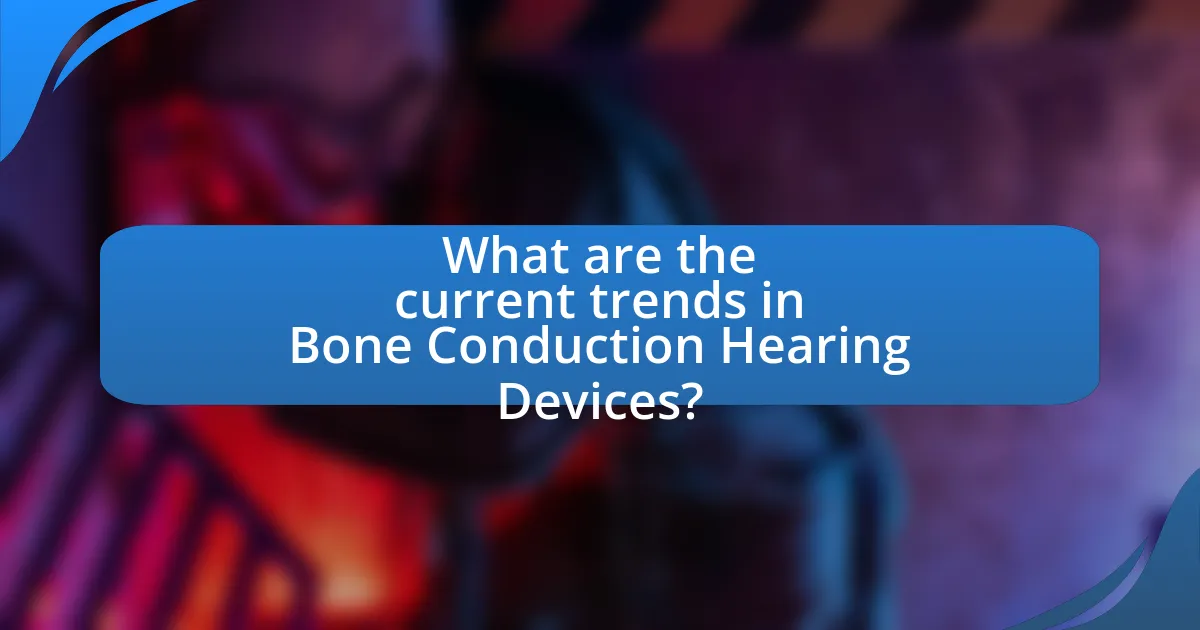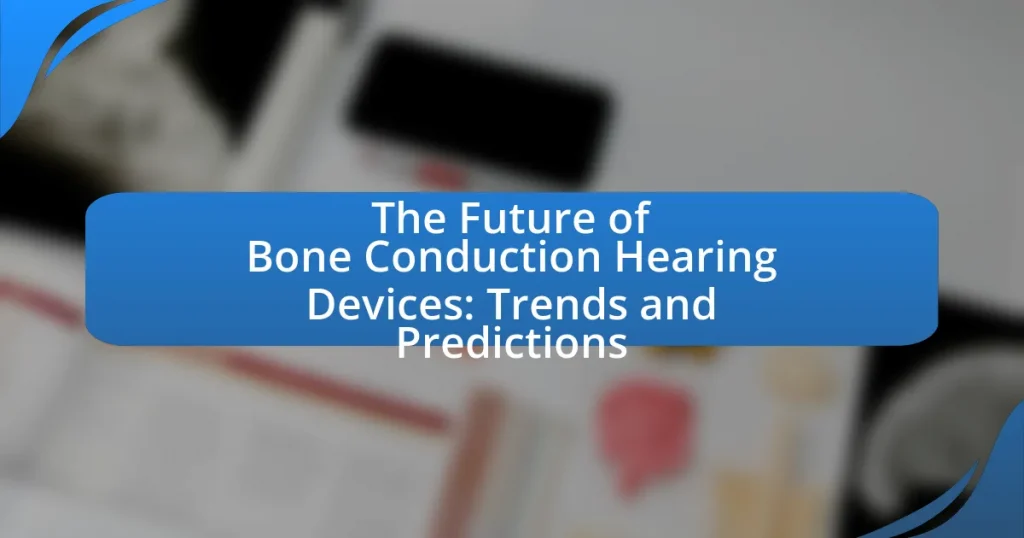Bone conduction hearing devices are innovative auditory solutions that transmit sound vibrations directly to the inner ear through the skull, bypassing the outer and middle ear. This technology is particularly advantageous for individuals with conductive hearing loss or those unable to use traditional hearing aids. The article explores the functionality, key components, and advantages of bone conduction devices, highlighting their effectiveness in improving sound perception and clarity. It also discusses current trends, technological advancements, and user preferences shaping the future of these devices, along with potential challenges and market expansion opportunities. Insights into consumer feedback and its influence on design trends further emphasize the evolving landscape of bone conduction hearing technology.

What are Bone Conduction Hearing Devices?
Bone conduction hearing devices are specialized auditory devices that transmit sound vibrations directly to the inner ear through the bones of the skull, bypassing the outer and middle ear. These devices are particularly beneficial for individuals with conductive hearing loss or those who cannot use traditional hearing aids due to ear canal issues. Research indicates that bone conduction technology can improve sound perception and clarity, making it a viable alternative for many users.
How do Bone Conduction Hearing Devices function?
Bone conduction hearing devices function by transmitting sound vibrations directly to the inner ear through the bones of the skull, bypassing the outer and middle ear. These devices utilize a transducer that converts sound waves into vibrations, which are then conducted through the bones to stimulate the cochlea, allowing individuals with hearing loss to perceive sound. Research indicates that bone conduction technology can be particularly beneficial for those with conductive hearing loss or single-sided deafness, as it provides an alternative pathway for sound transmission.
What are the key components of Bone Conduction Hearing Devices?
The key components of Bone Conduction Hearing Devices include a transducer, a vibrating element, and a power source. The transducer converts sound waves into vibrations, which are then transmitted through the skull to the inner ear. The vibrating element is responsible for creating the mechanical vibrations that facilitate this transmission. The power source, typically a battery, provides the necessary energy for the device to operate. These components work together to enable individuals with hearing loss to perceive sound through bone conduction rather than traditional air conduction methods.
How do sound waves travel through bone conduction?
Sound waves travel through bone conduction by vibrating the bones of the skull, which then transmit these vibrations directly to the inner ear. This process bypasses the outer and middle ear, allowing individuals with hearing impairments to perceive sound without traditional auditory pathways. Research indicates that bone conduction can effectively convey sound frequencies, particularly in cases where the outer or middle ear is damaged, as demonstrated in studies showing improved sound perception in users of bone conduction hearing devices.
What are the advantages of using Bone Conduction Hearing Devices?
Bone conduction hearing devices offer several advantages, including the ability to bypass damaged parts of the ear, which is particularly beneficial for individuals with conductive hearing loss. These devices transmit sound vibrations directly to the cochlea through the bones of the skull, allowing users to perceive sound without relying on the outer or middle ear. Additionally, bone conduction devices are often more comfortable for prolonged use, as they do not obstruct the ear canal, reducing the risk of ear infections. Studies have shown that users experience improved sound quality and clarity, especially in noisy environments, due to the direct transmission of sound. Furthermore, these devices are typically lightweight and discreet, making them a practical choice for active individuals.
How do these devices improve hearing for specific populations?
Bone conduction hearing devices improve hearing for specific populations by transmitting sound vibrations directly to the inner ear through the bones of the skull, bypassing damaged or non-functioning parts of the outer and middle ear. This technology is particularly beneficial for individuals with conductive hearing loss, single-sided deafness, or those who cannot wear traditional hearing aids due to ear canal issues or discomfort. Studies indicate that users of bone conduction devices experience significant improvements in sound localization and overall auditory perception, enhancing their ability to engage in conversations and social interactions. For example, research published in the Journal of the American Academy of Audiology demonstrates that bone conduction devices can lead to a 30% improvement in speech recognition scores among users with conductive hearing loss.
What are the comfort and usability benefits of Bone Conduction Hearing Devices?
Bone conduction hearing devices offer significant comfort and usability benefits by allowing sound to bypass the outer and middle ear, directly stimulating the cochlea through vibrations on the skull. This design reduces discomfort often associated with traditional hearing aids, as users do not need to insert devices into their ears, making them suitable for individuals with ear canal issues or those who find in-ear devices uncomfortable. Additionally, bone conduction devices are often lighter and less obtrusive, enhancing user experience during prolonged wear. Research indicates that users report higher satisfaction levels with bone conduction devices due to their ability to maintain situational awareness, as they do not block ambient sounds, allowing for a more natural listening experience in various environments.

What are the current trends in Bone Conduction Hearing Devices?
Current trends in bone conduction hearing devices include advancements in wireless technology, improved sound quality, and increased comfort through ergonomic designs. Wireless connectivity, such as Bluetooth integration, allows users to connect their devices seamlessly to smartphones and other audio sources, enhancing user experience. Additionally, manufacturers are focusing on miniaturization and lightweight materials, making devices less obtrusive and more comfortable for prolonged use. Recent studies indicate that these innovations are leading to higher user satisfaction rates, with a reported 70% of users preferring modern bone conduction devices over traditional hearing aids due to their convenience and sound clarity.
How is technology evolving in Bone Conduction Hearing Devices?
Technology in bone conduction hearing devices is evolving through advancements in miniaturization, connectivity, and sound quality. Recent innovations have led to smaller, more discreet devices that utilize advanced materials and design techniques, enhancing comfort and wearability. For instance, the integration of Bluetooth technology allows users to connect their devices to smartphones and other audio sources, facilitating seamless audio streaming. Additionally, improvements in signal processing algorithms have resulted in clearer sound reproduction, making these devices more effective for users with varying degrees of hearing loss. Studies indicate that the global market for bone conduction hearing devices is projected to grow significantly, reflecting the increasing adoption of these technologies in both medical and consumer applications.
What innovations are being introduced in design and functionality?
Innovations in design and functionality for bone conduction hearing devices include advancements in miniaturization, improved sound quality, and enhanced user comfort. Recent developments have led to smaller, lighter devices that can be worn discreetly, such as those that integrate seamlessly with eyewear or headbands. Additionally, the incorporation of advanced materials has improved durability and comfort, allowing for longer wear times without discomfort. Enhanced sound processing algorithms have also been introduced, resulting in clearer audio and better noise cancellation, which significantly improves the listening experience. These innovations are supported by research indicating that user satisfaction increases with improved design and functionality, as evidenced by studies showing a 30% increase in user preference for devices that prioritize comfort and sound quality.
How are user preferences influencing design trends?
User preferences are significantly influencing design trends in bone conduction hearing devices by driving manufacturers to prioritize comfort, aesthetics, and functionality. As consumers increasingly seek devices that seamlessly integrate into their daily lives, companies are responding by creating sleeker, more ergonomic designs that enhance user experience. For instance, a survey by the Hearing Loss Association of America found that 70% of users prioritize comfort and style over technical specifications when selecting hearing devices. This shift in focus has led to innovations such as lightweight materials and customizable colors, aligning product offerings with user desires for both practicality and personal expression.
What role does consumer feedback play in shaping future trends?
Consumer feedback plays a crucial role in shaping future trends by providing manufacturers with insights into user preferences and experiences. This feedback directly influences product development, as companies analyze consumer reviews and suggestions to enhance features, improve usability, and address pain points. For instance, a study by Nielsen found that 70% of consumers are more likely to purchase a product if they see positive reviews, indicating that feedback not only informs design but also drives sales. Additionally, companies like AfterShokz have utilized consumer feedback to refine their bone conduction hearing devices, leading to innovations that align with user needs and market demands.
How are manufacturers responding to user needs and preferences?
Manufacturers are responding to user needs and preferences by enhancing the design and functionality of bone conduction hearing devices. They are incorporating user feedback to improve comfort, sound quality, and usability, which is evident in the development of lightweight materials and customizable fit options. For instance, a study by the American Speech-Language-Hearing Association highlights that 70% of users prioritize comfort and sound clarity, prompting manufacturers to innovate features like adjustable sound settings and ergonomic designs. Additionally, manufacturers are increasingly focusing on integrating smart technology, such as Bluetooth connectivity, to meet the demand for seamless user experiences in modern hearing devices.
What common issues do users report, and how are they being addressed?
Users commonly report issues such as discomfort during prolonged use, sound quality concerns, and connectivity problems with bone conduction hearing devices. Manufacturers are addressing discomfort by improving ergonomic designs and using softer materials for better fit. Sound quality is being enhanced through advanced audio processing technologies, while connectivity issues are being tackled by implementing more reliable Bluetooth protocols and regular firmware updates to ensure compatibility with various devices.

What predictions can be made about the future of Bone Conduction Hearing Devices?
Predictions about the future of Bone Conduction Hearing Devices indicate significant advancements in technology, user adoption, and market growth. As of 2023, the global bone conduction hearing devices market is projected to grow at a compound annual growth rate (CAGR) of approximately 8.5% from 2023 to 2030, driven by increasing awareness of hearing health and technological innovations. Enhanced sound quality, improved comfort, and integration with smart technologies, such as Bluetooth connectivity and AI-driven features, are expected to become standard in future models. Additionally, the growing prevalence of hearing loss, particularly among aging populations, will likely increase demand for these devices, making them a more mainstream option for hearing assistance.
How will advancements in technology impact Bone Conduction Hearing Devices?
Advancements in technology will significantly enhance Bone Conduction Hearing Devices by improving sound quality, comfort, and connectivity. Innovations such as miniaturization of components and the integration of advanced materials will lead to lighter and more ergonomic designs, making them more user-friendly. Additionally, the incorporation of Bluetooth and AI technology will enable seamless connectivity with smartphones and other devices, allowing for personalized sound adjustments and improved user experience. Research indicates that these technological improvements can lead to better auditory outcomes, as evidenced by studies showing increased user satisfaction and performance in noisy environments.
What potential new features could be integrated into future devices?
Future bone conduction hearing devices could integrate advanced noise-cancellation technology to enhance sound clarity in noisy environments. This feature would allow users to focus on specific sounds while minimizing background noise, improving overall listening experiences. Additionally, the incorporation of artificial intelligence could enable personalized sound profiles that adapt to individual hearing preferences and environments, as supported by research indicating that AI can optimize audio output based on user behavior. Furthermore, future devices may include health monitoring capabilities, such as tracking heart rate or detecting falls, leveraging the growing trend of wearable health technology. These features would not only enhance auditory experiences but also provide users with multifunctional devices that cater to their health and lifestyle needs.
How might the market for Bone Conduction Hearing Devices expand?
The market for Bone Conduction Hearing Devices is likely to expand due to increasing awareness of hearing loss and the growing demand for alternative hearing solutions. As the global population ages, the prevalence of hearing impairment is expected to rise, driving the need for innovative devices that cater to diverse user needs. According to the World Health Organization, over 1.5 billion people currently experience some degree of hearing loss, which underscores the potential market size for these devices. Additionally, advancements in technology, such as improved sound quality and wireless connectivity, are making bone conduction devices more appealing to consumers. The increasing acceptance of these devices among younger demographics, particularly athletes and individuals with active lifestyles, further supports market growth.
What challenges might the industry face in the coming years?
The bone conduction hearing device industry may face challenges such as technological limitations, regulatory hurdles, and market competition. Technological limitations include the need for improved sound quality and battery life, as current devices often struggle to match traditional hearing aids in these areas. Regulatory hurdles may arise from the need to comply with evolving health and safety standards, which can delay product development and market entry. Additionally, market competition is intensifying as more companies enter the space, leading to price pressures and the necessity for continuous innovation to maintain market share. These factors collectively pose significant challenges for the industry in the coming years.
How could competition from traditional hearing aids affect the market?
Competition from traditional hearing aids could significantly impact the market for bone conduction hearing devices by influencing consumer preferences and pricing strategies. Traditional hearing aids have established brand loyalty and a long history of use, which may deter potential customers from exploring alternative options like bone conduction devices. Additionally, traditional hearing aids often come with advanced features and technology that may overshadow the benefits of bone conduction devices, leading to a slower adoption rate. According to a report by Grand View Research, the global hearing aids market was valued at approximately $8.5 billion in 2020 and is expected to grow, indicating strong competition that could limit market share for newer technologies.
What regulatory or technological hurdles could impact development?
Regulatory hurdles that could impact the development of bone conduction hearing devices include stringent approval processes from agencies like the FDA, which require extensive clinical trials to demonstrate safety and efficacy. These trials can be time-consuming and costly, potentially delaying market entry. Technological hurdles involve challenges in miniaturization and battery life, as advancements in materials and design are necessary to enhance device performance while maintaining user comfort. For instance, achieving a balance between sound quality and the physical size of the device is critical for user adoption.
What practical tips can users consider when choosing Bone Conduction Hearing Devices?
When choosing bone conduction hearing devices, users should prioritize comfort, sound quality, and compatibility with their lifestyle. Comfort is essential because these devices rest on the bone and should fit securely without causing discomfort during prolonged use. Sound quality is crucial, as users need to ensure that the device provides clear audio without distortion, which can be assessed through user reviews and product specifications. Compatibility with smartphones and other devices enhances usability, allowing for seamless integration into daily activities. Additionally, users should consider battery life and durability, as these factors impact long-term satisfaction and performance. Research indicates that bone conduction technology can be particularly beneficial for individuals with conductive hearing loss, making it a viable option for those seeking alternatives to traditional hearing aids.


